Are you passionate about growing college enrollment and breaking down barriers to education within your community?
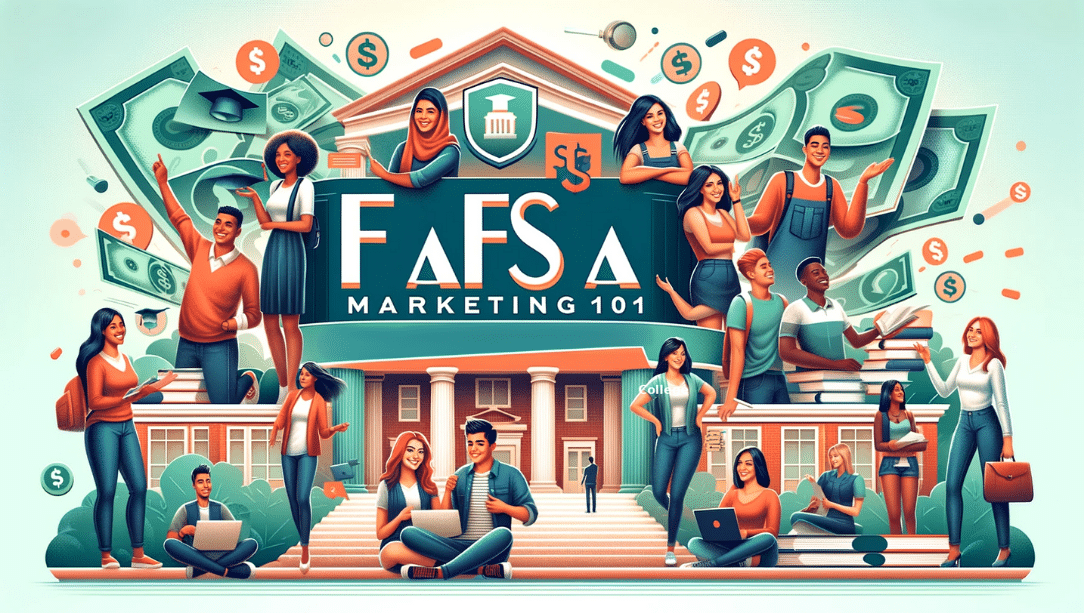
As community college marketers, our role is crucial in shaping the future for countless students. Imagine the impact of helping every student access the financial aid they need to enroll and pursue their academic dreams.
Each year, billions in financial aid goes unclaimed, and to access this funding for college, students need to complete one critical form: the FAFSA. (National College Attainment Network (NCAN))
In this guide, we'll explore strategic approaches to promoting the Free Application for Federal Student Aid (FAFSA) within your community college setting. We’ll delve into understanding your audience, leveraging social media, collaborating with high schools, and providing ongoing support, equipping you with practical insights and actionable steps to empower your community and drive increased enrollment and student retention.
1. Understanding Your Audience
The first step in effectively promoting FAFSA is to gain a deep understanding of your audience. Who are the students in your community, and what are the factors that motivate or hinder their FAFSA completion? These are great questions to ask your current students as well as the financial aid advisors. By delving into their motivations and misconceptions, you can shape a more effective outreach strategy.
Motivations
Educational Aspirations
Motivation: Many students aspire to pursue higher education to improve their career prospects and achieve personal goals.
Strategy: Tailor your messaging to emphasize how completing FAFSA is the gateway to turning these aspirations into tangible educational opportunities.
Financial Concerns
Motivation: Students and their families are often motivated by the prospect of accessing financial aid to ease the burden of tuition and related expenses.
Strategy: Highlight the practical benefits of FAFSA, emphasizing how it can significantly alleviate the financial strain associated with college.
Career Opportunities
Motivation: Some students may be motivated by the desire to enhance their career opportunities and earning potential through higher education.
Strategy: Showcase success stories of individuals who, with the help of FAFSA, achieved career advancements and fulfilling professional journeys.
Misconceptions
Perceived Complexity
Misconception: Students may perceive the FAFSA process as complex and overwhelming.
Strategy: Offer simplified step-by-step guides and demystify the process through workshops in high schools, on campus and online, making it clear that support is available every step of the way.
Fear of Debt
Misconception: There might be a misconception that FAFSA is only for loans, leading to a fear of accumulating debt.
Strategy: Emphasize that FAFSA opens doors to various forms of financial aid, including grants and scholarships that do not require repayment.
Lack of Awareness
Misconception: Some students may not be aware of the opportunities FAFSA can unlock.
Strategy: Launch early awareness campaigns, utilizing various channels to ensure that students and their families are informed about the benefits and importance of FAFSA.
Deadline Misunderstandings
Misconception: Students may underestimate the importance of timely FAFSA submissions, thinking they have more time than they actually do.
Strategy: Emphasize the significance of filing early and the potential consequences of missing deadlines, showcasing success stories of those who benefitted from timely submissions. Also, remind current students that FAFSA is not a one-time application, it needs to be submitted annually.
2. Identifying Promotional Channels
A multi-channel approach is crucial to reach fragmented audiences effectively. The top channels for FAFSA promotion include social media, emails, physical posters on campus, and workshops. Each of these channels offers unique opportunities to engage with your audience and reinforce your message.
3. Creating Targeted Communications
Social Media
Social media serves as an invaluable tool for connecting with your community and keeping them informed about crucial updates, especially regarding FAFSA. To optimize your impact:
- Develop a Strategic Content Calendar: Plan your social media content focusing on FAFSA awareness. This calendar should balance a variety of content types, including informative posts, captivating infographics, and real-life success stories, all tailored to resonate with your specific audiences and platforms.
- Leverage the Power of Storytelling: Create a series of engaging short video clips where students share their personal FAFSA journeys. These narratives can provide both inspiration and practical insight into the process, making the idea of completing FAFSA more approachable and less daunting.
- Foster Interactive Engagement: Increase audience interaction by incorporating interactive elements. Pose thought-provoking questions, conduct polls, or create quizzes to gauge and respond to your audience’s level of awareness and their concerns about FAFSA. This approach not only gathers valuable insights but also builds a sense of community and involvement.
- Utilize Social Student Ambassadors: If not already in place, consider launching a social student ambassador program. Recruit students who have successfully navigated the FAFSA process. Their authentic voices and firsthand experiences can deeply resonate with both prospective and current students, adding a relatable and trustworthy element to your promotional efforts.
- Adhere to the Fundamentals of Social Media Engagement: Reference the “Fundamentals of Social Content” graph as a guide. Strive to ensure that around 75% of your content falls into the categories of Entertainment, Inspiration, and Education. This blend ensures that your content remains engaging, uplifting, and informative, maximizing its appeal and effectiveness.
Fundamentals of Social Content
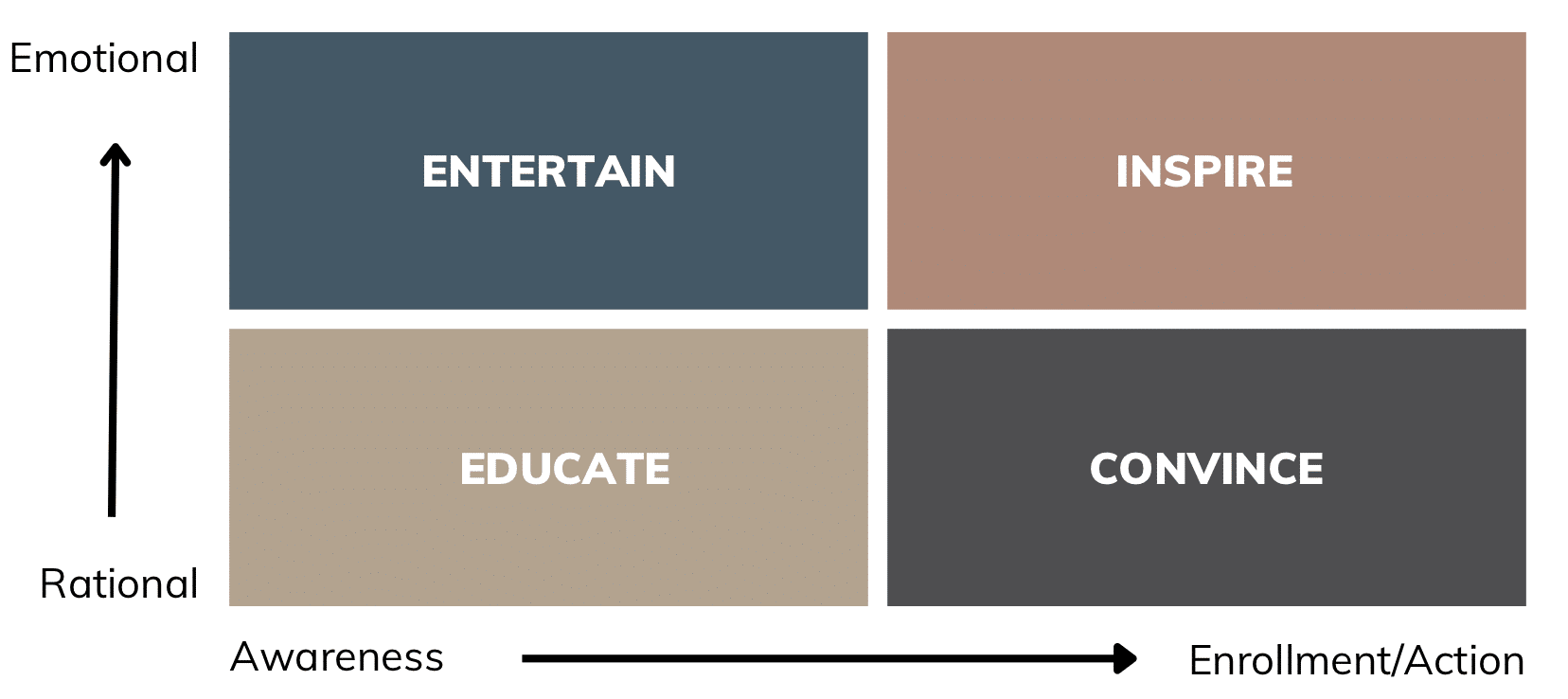
Emails
Implement targeted email campaigns to reach students and families directly. Highlight key FAFSA deadlines, include step-by-step guides, FAQs, and links to resources.
- Segmented Email Lists: Tailor your email campaigns by segmenting your audience. Create different versions of emails for various segments such as first-year students, returning students, and their families. This allows for more personalized communication that addresses specific needs or concerns of each group.
- Clear and Concise Subject Lines: Use engaging, clear subject lines that communicate the importance of the content. A compelling subject line increases the likelihood of your email being opened.
- Mobile Optimization: Ensure that your emails are mobile-friendly, as many students and families access emails primarily through mobile devices. This includes responsive design and easily clickable links.
Physical Posters on Campus
Leveraging physical posters and flyers can be a highly effective way to catch students' attention on campus. To maximize their impact:
- Design with Clarity and Impact: Ensure that your posters and flyers feature bold, clear messaging that immediately grabs attention. Use eye-catching designs and concise, impactful wording that communicates the key messages at a glance. Include essential details like deadlines, contact information, and a QR code linking to more information or the application page.
- Strategic Placement for Optimal Visibility: Distribute these materials in high-traffic areas to ensure maximum visibility. Ideal locations include bathrooms, cafeterias, classrooms, student lounges, and main hallways. The goal is to place these reminders where students frequently visit throughout their day.
- Incorporate a Call to Action: Each poster should have a strong call to action, encouraging students to take the next step, whether it’s visiting a website, attending an information session, or starting their application process.
- Engage Faculty as Advocates: Partner with faculty members to act as additional voices reinforcing the message. They can remind students of important deadlines and offer encouragement to complete the FAFSA process. Consider providing them with digital versions of the poster content for use in their digital communications or classroom presentations.
- Consistent Refreshment and Updates: Regularly update and refresh the posters to maintain student interest and attention. Changing designs or messages can prevent the information from blending into the background over time.
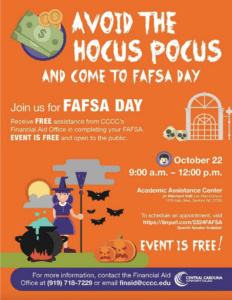
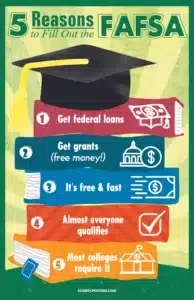
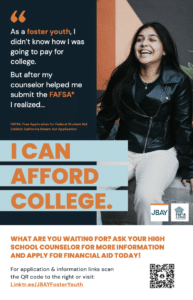
https://www.cccc.edu/news/story.php?story=10692
https://schoolposters.com/products/p3864-5-reasons-to-fill-out-the-fafsa-poster
Workshops and Webinars
- Enhanced High School Collaboration: Forge partnerships with local high schools to reach students before they graduate. Conduct informational sessions and workshops in collaboration with high school counselors. Provide resources for high school teachers to seamlessly integrate FAFSA information into their curriculum. This collaborative effort ensures that students are well-informed about the FAFSA process from an early stage.
- On-campus Workshops for Diverse Audiences: Organize on-campus FAFSA completion workshops to provide hands-on assistance. Partner with financial aid experts who can guide students and families through the application process. Consider offering flexible timing, including evenings and weekends, to accommodate the diverse schedules of your community. A supportive environment can make the FAFSA process less intimidating.
- Interactive Online Webinars: Host live and recorded events for broader accessibility. Make online webinars interactive with live Q&A segments, polls, and breakout rooms for small group discussions.
- Accessibility and Language Options: Ensure all online materials are accessible, with closed captions for videos and language options for non-English speakers.
- Promotional Campaign for Recorded Content: Develop a promotional campaign for your recorded webinars, highlighting key segments or takeaways. Use these snippets across social media platforms and your website to reach a broader audience.
This guide provides a foundational approach for promoting FAFSA effectively. By understanding your audience, leveraging the right channels, and creating targeted communications, you can significantly impact college enrollment and student success in your community.
Text
Ready to Use FAFSA Social Media Campaign

For just $100, unlock a 2-month Social Media FAFSA Campaign package that includes:
Why Choose Our FAFSA Social Media Campaign Package?
Time-Saving:
Our team takes care of the content creation, saving you valuable time that can be directed towards other essential tasks in your enrollment strategy.
Expertise:
Benefit from our team's expertise in crafting content that resonates with your community and encourages FAFSA completion.
